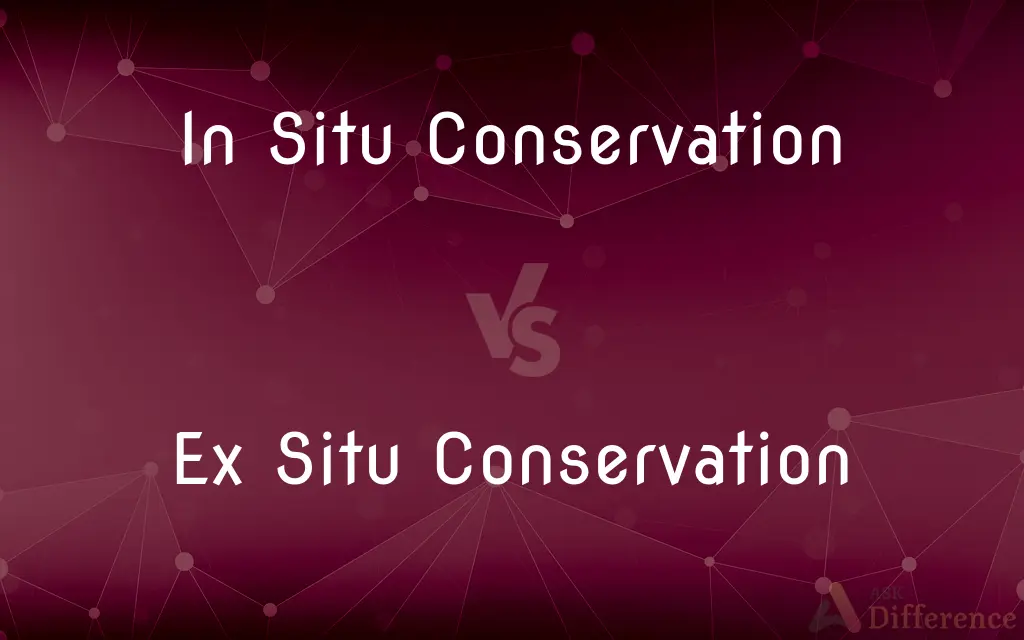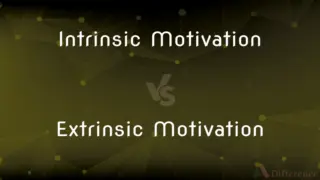In Situ Conservation vs. Ex Situ Conservation — What's the Difference?
By Tayyaba Rehman — Published on December 23, 2023
"In Situ Conservation" means conserving species in their natural habitats, while "Ex Situ Conservation" involves protecting species outside their natural environments.

Difference Between In Situ Conservation and Ex Situ Conservation
Table of Contents
ADVERTISEMENT
Key Differences
In Situ Conservation and Ex Situ Conservation both aim to conserve and protect biodiversity, but their methodologies and settings differ. In Situ Conservation pertains to the preservation of species in their natural habitats, like forests or wetlands, ensuring they continue to exist in their indigenous environments. Meanwhile, Ex Situ Conservation means taking steps to safeguard species outside their natural habitats, often due to threats in their native settings.
Considering In Situ Conservation, the emphasis is on maintaining and recovering natural ecosystems. This type of conservation might involve creating protected areas such as national parks or wildlife sanctuaries. Ex Situ Conservation, on the other hand, focuses on the protection of species by removing individuals from threatened habitats and placing them in a controlled or new environment, like zoos or botanical gardens.
In Situ Conservation allows species to adapt and evolve in real-time to environmental changes, maintaining the natural balance of ecosystems. This method acknowledges the intricate connections species have with their environments. Contrastingly, Ex Situ Conservation offers a more controlled environment, which might be essential when a species' natural habitat is rapidly degrading or when immediate threats to survival exist.
One of the advantages of In Situ Conservation is the comprehensive preservation of biodiversity within an ecosystem. It upholds not only species but also their relationships with other organisms. Ex Situ Conservation, while not offering this holistic approach, provides a backup plan, especially for species on the brink of extinction, and can also aid scientific research and breeding programs.
In essence, In Situ Conservation is about preserving the "home" of the species, ensuring they flourish in their natural conditions. Ex Situ Conservation, conversely, is like creating a "safe house" for species, ensuring their survival when their homes are under threat.
ADVERTISEMENT
Comparison Chart
Location
Natural habitat
Outside natural habitat
Methodology
Protection of entire ecosystem
Protection of individual species
Control
Less controlled
Highly controlled
Application
Creation of protected areas
Creation of zoos, botanical gardens, seed banks
Interaction with Environment
Direct interaction with native environment
Limited or controlled interaction with environment
Compare with Definitions
In Situ Conservation
Preservation of biodiversity in its entirety.
Wetland preservation is an effort towards In Situ Conservation.
Ex Situ Conservation
Conservation of species in artificial or controlled environments.
Zoos play a role in Ex Situ Conservation efforts.
In Situ Conservation
Protection of ecosystems and natural habitats.
The coral reefs are protected through In Situ Conservation measures.
Ex Situ Conservation
Involves creating gene banks, aquariums, or botanical gardens.
Seed banks store seeds as a measure of Ex Situ Conservation.
In Situ Conservation
Conservation of species in their natural habitats.
National parks are a prime example of In Situ Conservation.
Ex Situ Conservation
A way to study and research species in a controlled setting.
Studying animal behavior in zoos is made possible through Ex Situ Conservation.
In Situ Conservation
Maintenance of recovering populations in the wild.
Protecting a forest helps in the In Situ Conservation of its resident species.
Ex Situ Conservation
Strategy often used when In Situ Conservation isn't viable.
Breeding programs in captivity support Ex Situ Conservation of threatened species.
In Situ Conservation
A method that promotes natural evolutionary processes.
In Situ Conservation ensures species adapt to environmental changes over time.
Ex Situ Conservation
Protection of species outside their natural habitats.
Endangered plants kept in botanical gardens are part of Ex Situ Conservation.
Common Curiosities
Does In Situ Conservation support ecosystem diversity?
Yes, In Situ Conservation supports the diversity of entire ecosystems, not just individual species.
What is the main goal of In Situ Conservation?
The main goal of In Situ Conservation is to preserve species in their natural habitats, maintaining ecological balance.
When is Ex Situ Conservation typically employed?
Ex Situ Conservation is employed when species are at high risk in their natural habitats or for research and breeding purposes.
Are botanical gardens a form of Ex Situ Conservation?
Yes, botanical gardens are a form of Ex Situ Conservation where plants are conserved outside their natural habitats.
Can Ex Situ Conservation specimens be reintroduced to the wild?
Yes, species conserved via Ex Situ methods can sometimes be reintroduced to their natural habitats.
What are some challenges of Ex Situ Conservation?
Challenges include genetic drift, limited space, and potential adaptation to artificial environments.
Which is more cost-effective: In Situ or Ex Situ Conservation?
It varies based on context, but In Situ Conservation is often more cost-effective in maintaining biodiversity at large.
Is In Situ Conservation always effective?
While In Situ Conservation is ideal, external threats like pollution or habitat degradation can make it challenging.
What role do seed banks play in Ex Situ Conservation?
Seed banks store genetic material of plants, ensuring their survival and aiding in potential future reintroductions.
How does In Situ Conservation affect local communities?
In Situ Conservation can support local communities by promoting ecotourism and sustainable resource use.
Can In Situ Conservation help combat climate change effects?
Yes, by preserving natural habitats like forests, In Situ Conservation can help in carbon sequestration and combating climate change.
Is Ex Situ Conservation a long-term solution?
Ex Situ Conservation is often seen as a short-term remedy, but it can be a stepping stone for long-term recovery strategies.
How does In Situ Conservation promote natural behaviors?
By preserving species in their natural habitats, In Situ Conservation ensures they exhibit and maintain natural behaviors.
Why is Ex Situ Conservation important for research?
Ex Situ Conservation allows scientists to study species in controlled settings, making certain research easier.
Are there ethical concerns with Ex Situ Conservation?
Yes, concerns include the potential for animals to suffer in captivity or for species to become too domesticated.
Share Your Discovery

Previous Comparison
L Isomers vs. D Isomers
Next Comparison
Intrinsic Motivation vs. Extrinsic MotivationAuthor Spotlight
Written by
Tayyaba RehmanTayyaba Rehman is a distinguished writer, currently serving as a primary contributor to askdifference.com. As a researcher in semantics and etymology, Tayyaba's passion for the complexity of languages and their distinctions has found a perfect home on the platform. Tayyaba delves into the intricacies of language, distinguishing between commonly confused words and phrases, thereby providing clarity for readers worldwide.














































